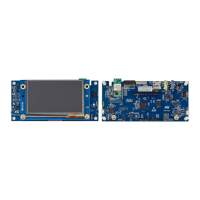7.6.5 Audio
An audio codec is connected to either I2S6 or SAI1 interface of STM32H7B3LIH6Q to support the TDM feature.
I2S6 interface is used by default.
This feature can implement audio recording on an analog microphone and audio playback of a different audio
stream on headphones and lineout at the same time.
The audio codec communicates with STM32H7B3LIH6Q via the I2C4 bus, which is shared with the camera
module, the TFT-LCD, the ARDUINO
®
Uno connectors, the STMod+ connector, and the Wi‑Fi
®
module. The
I
2
C-bus addresses of the audio codec are 0x95 and 0x94.
Several audio connections are available on the STM32H7B3I-DK board:
• An analog microphone input which is connected to ADC of the audio codec through the blue audio jack CN6
• An external speaker which can be connected to the audio codec via green audio jack CN5
• A CN3 connector offers the possibility to connect a microphone module with up to five ST-MEMS
microphones. They are connected to the digital input microphones of STM32H7B3LIH6Q and are managed
by the DFSDM interface.
Note: When using the I2S6 interface, make sure that SB46 (I2S6_MCK) and SB31 (I2S6_WS) are ON.
7.6.6 CAN FD
The STM32H7B3I-DK board supports one channel of CAN FD (Flexible Data Rate CAN) compliant bus based on
3V3 CAN transceiver.
The standby signal on the CAN‑FD transceiver is controlled by PH8 GPIO of STM32H7B3LIH6Q.
Limitations:
CAN‑FD signals are shared with STMod+ signals. As a consequence, the user must take care that nothing is
connected to the STMod+ connector (1, 4 pins), or both SB7 and SB12 must be OFF when the FD-CAN1 bus is
activated.
Table 9. FD-CAN1 – Solder bridge configuration
Solder bridge
Setting
(1)
Configuration
SB3, SB4, SB5
SB3, SB4, SB5 ON
TXD, RXD, and STBY of MCD2562FD are connected to
PA11 (FDCAN1_RX), PA12 (FDCAN1_TX), and PH8 (GPIO) of
STM32H7B3LIH6Q MCU.
SB3, SB4, SB5 OFF
FDCAN1 bus not connected: TXD, RXD, and STBY of MCD2562FD are
not connected to PA11 (FDCAN1_RX), PA12 (FDCAN1_TX), and PH8
(GPIO) of STM32H7B3LIH6Q MCU.
1. The default configuration is shown in bold.
7.6.7 Octo‑SPI NOR Flash memory
The STM32H7B3I-DK board includes a 512-Mbit Octo‑SPI NOR Flash memory device, which is connected to
the OCTOSPI1 interface of the STM32H7B3LIH6Q microcontroller. The Octo‑SPI NOR Flash memory device
operates in a single transfer rate (STR) or a double transfer rate (DTR) mode. The RESETn of the Flash memory
is connected to the general reset (NRST) of the STM32H7B3I-DK Discovery kit.
7.6.8 SDRAM memory
The STM32H7B3I-DK board adds an external 128-Mbit SDRAM, which is connected to STM32H7B3LIH6Q
flexible memory controller FMC interface.
UM2569
Board functions
UM2569 - Rev 6
page 20/53

